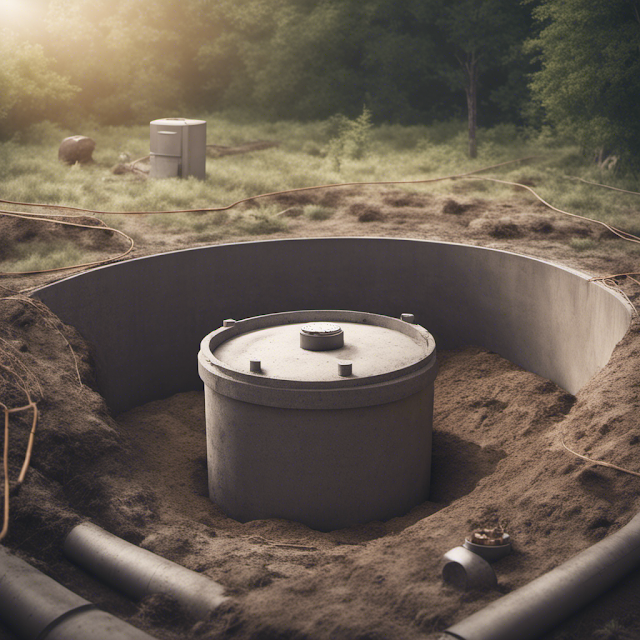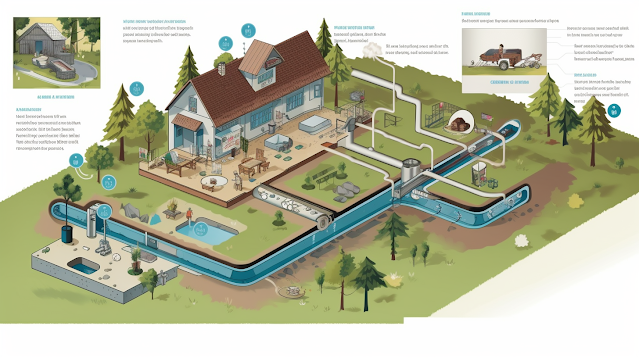Site Evaluation For Septic Systems: Your Key To A Flawless Waste Management Solution
 |
| Site Evaluation For Septic Systems |
Are you in the process of installing a septic system on your property? If so, it is crucial that you understand the importance of conducting a thorough site evaluation.
Site evaluation for septic systems is the key to ensuring a flawless waste management solution that not only meets environmental and health safety standards but also functions efficiently for years to come.
During the site evaluation process, several factors are taken into consideration. These include soil type, topography, groundwater levels, and proximity to water bodies.
By analyzing these factors, professionals can determine the most suitable location for your septic system and design it accordingly. This scientific approach ensures that your waste management solution will be optimized for maximum efficiency while minimizing potential risks to the environment and public health.
By investing time and resources into proper site evaluation for your septic system, you can reap numerous benefits in the long run. Firstly, an efficient septic system will prevent costly repairs or replacements down the line. Additionally, a well-designed system will minimize any negative impact on nearby water sources or ecosystems.
Moreover, by adhering to environmental and health safety standards from the start, you can avoid potential legal issues or fines in the future.
In conclusion, conducting a comprehensive site evaluation for your septic system is essential to ensure a flawless waste management solution that meets all necessary requirements while providing long-term efficiency and sustainability.
Importance of Site Evaluation for Septic Systems
Site evaluation is crucial for septic systems because it ensures a flawless waste management solution. Without a thorough site survey and soil analysis, the installation of a septic system can lead to numerous problems down the line.
A site survey allows professionals to assess the topography, drainage patterns, and proximity to water sources. This information is vital in determining the optimal location for the septic system, as it should be situated away from wells, surface water bodies, and areas prone to flooding.
Additionally, a soil analysis provides valuable insights into the soil composition and permeability. Different types of soils have varying abilities to absorb and treat wastewater effectively. By analyzing the soil conditions on-site, experts can design a septic system that matches these specific requirements.
Moreover, conducting a site evaluation for septic systems helps identify any potential limitations or challenges that may affect its functionality in the long run. Factors such as high groundwater levels or shallow bedrock can significantly impact how well a septic system operates. By addressing these issues during the evaluation process, appropriate measures can be implemented to mitigate any future problems. For instance, if there are concerns about groundwater contamination due to poor soil absorption capabilities found during the analysis phase, an alternative wastewater treatment method may be recommended instead of traditional drain fields.
Site evaluation plays an integral role in ensuring an efficient waste management solution for septic systems. Through detailed site surveys and comprehensive soil analyses, professionals are equipped with essential information needed to make informed decisions regarding system placement and design considerations. By taking into account factors like topography and soil properties during this process, potential challenges can be identified early on and appropriate solutions can be devised accordingly - ultimately leading to a flawlessly functioning septic system for years to come.
Factors Considered in Site Evaluation
When assessing a location for a septic system, various factors are taken into account. One of the most important aspects is site conditions. This includes evaluating the topography, groundwater levels, and proximity to bodies of water or wells. The site should ideally have sufficient space for the septic tank and drainfield, with enough distance from buildings, property lines, and other structures. Additionally, factors such as accessibility for maintenance and repairs should be considered during the evaluation process.
Another crucial factor in site evaluation for septic systems is soil analysis. Soil composition plays a significant role in determining the suitability of a location for wastewater treatment. A percolation test is often conducted to assess how well the soil can absorb water from the drainfield. This helps determine if the soil has adequate permeability to allow efficient filtration and treatment of wastewater. Additionally, soil texture and structure influence how well it can retain moisture and support bacterial activity necessary for proper decomposition of waste materials. By analyzing these soil characteristics, professionals can ensure that the chosen site will provide optimal conditions for an effective septic system installation and long-term waste management solution.
Designing an Efficient Septic System
To create an effective septic system, it's essential to focus on the design process. A well-designed system can ensure proper waste management and minimize the risk of environmental contamination.
One important aspect to consider is septic system maintenance. Designing a system that allows for easy access and regular maintenance can greatly contribute to its efficiency and longevity. Incorporating features such as easily accessible cleanout ports and inspection pipes can make it easier for professionals to inspect and maintain the system, ensuring that it operates smoothly.
Another crucial factor in designing an efficient septic system is adherence to septic system regulations. Local regulations vary, but they typically include requirements related to setback distances from water sources, soil characteristics, tank size, drainfield design, and overall capacity of the system. By following these regulations during the design phase, you can avoid potential legal issues in the future and ensure that your septic system meets all necessary standards. Additionally, complying with regulations helps protect public health by preventing contamination of groundwater or surface water sources.
Overall, when designing an efficient septic system, it's important to prioritize maintenance accessibility and compliance with local regulations. These considerations will not only help optimize waste management but also prevent potential environmental hazards associated with improper sewage treatment. By focusing on these aspects during the design process, you can create a reliable and long-lasting septic system for your property.
Ensuring Environmental and Health Safety
Ensuring the safety of the environment and public health is paramount in designing an efficient septic system.
The environmental impact of a poorly designed or malfunctioning septic system can be significant. Improper waste management can lead to contamination of groundwater, surface water, and soil, causing pollution and posing a risk to both human and ecological health.
Therefore, it is crucial to adhere to strict health regulations and guidelines when planning and implementing a septic system.
Health regulations play a vital role in ensuring that septic systems are designed and operated in a way that minimizes potential risks to public health. These regulations typically cover aspects such as proper sizing and location of the septic tank, adequate treatment processes, regular maintenance requirements, and safe disposal methods for effluent.
By following these regulations, the risk of pathogens or harmful chemicals entering the environment can be minimized significantly. Additionally, monitoring systems should be put in place to regularly assess water quality and detect any signs of contamination promptly.
Designing an efficient septic system goes hand in hand with ensuring environmental protection and public health safety. Adhering to strict health regulations helps minimize the environmental impact by preventing contamination of groundwater, surface water, and soil. By incorporating proper sizing, treatment processes, maintenance requirements, and monitoring systems into the design plan, we can create a waste management solution that effectively protects both our environment's well-being and public health from potential hazards associated with improper sewage disposal.
Benefits of Proper Site Evaluation for Waste Management
Benefits of properly assessing the location for waste disposal can lead to a more efficient and effective way of protecting the environment and public health. By conducting a thorough site evaluation for waste management, you can identify cost-effective solutions that promote long-term sustainability.
A proper assessment allows you to determine the most suitable location for your septic system, taking into consideration factors such as soil type, groundwater level, and proximity to water bodies.
One of the key benefits of a proper site evaluation is the ability to design a septic system that is cost-effective. By understanding the specific characteristics of the site, you can optimize the design and construction process, reducing unnecessary expenses. Additionally, by choosing an appropriate location for your septic system, you can minimize potential risks such as groundwater contamination or soil saturation. This not only prevents environmental damage but also reduces the likelihood of public health issues arising from poor waste management practices.
Another advantage of conducting a thorough site evaluation is ensuring long-term sustainability. By considering factors like soil permeability and slope stability during the assessment process, you can design a septic system that will function efficiently over time. This helps avoid costly repairs or replacements in the future and promotes sustainable waste management practices.
Properly assessing the location for waste disposal offers numerous benefits when it comes to protecting both the environment and public health. It enables you to identify cost-effective solutions while promoting long-term sustainability. By incorporating technical expertise and scientific analysis into site evaluations, we can ensure flawless waste management systems that effectively safeguard our surroundings for years to come.
Frequently Asked Questions
How much does a site evaluation for a septic system typically cost?
A site evaluation for a septic system typically costs between $500 and $1,000. This cost estimation is necessary to conduct a benefits analysis, which helps determine if the investment in a septic system is worthwhile.
Can I perform a site evaluation for a septic system myself, or is it necessary to hire a professional?
Performing a septic system site evaluation yourself is possible, but hiring a professional ensures accuracy and adherence to regulations. The cost varies, but it's essential to conduct an evaluation before installation. It typically takes a few hours to complete.
What are the potential consequences of not conducting a site evaluation before installing a septic system?
Not conducting a site evaluation before installing a septic system can lead to potential consequences such as groundwater contamination, soil saturation, and system failure. The importance of a site evaluation cannot be overstated in ensuring proper waste management.
Are there any specific regulations or permits required for a septic system installation after completing a site evaluation?
Specific regulations and permits are required for septic system installation. These include obtaining the necessary permits from local health departments and complying with state, county, and municipal regulations to ensure proper installation and operation of the system.
How long does a site evaluation for a septic system typically take to complete?
A site evaluation for a septic system typically takes about 1-2 hours to complete. The process involves analyzing soil conditions, topography, and other factors to determine the suitability of the site for installation.
Conclusion
In conclusion, site evaluation for septic systems is a crucial step in ensuring a flawless waste management solution. By carefully assessing the site, various factors such as soil type, slope, and proximity to water sources are taken into account to design an efficient septic system.
This scientific approach allows for the optimization of waste treatment and disposal processes.
Moreover, proper site evaluation plays a vital role in ensuring environmental and health safety. By considering factors like groundwater contamination risks and setback distances from wells or surface water bodies, potential hazards can be mitigated effectively.
This analytical approach not only prevents pollution but also safeguards public health by minimizing the chances of diseases caused by improper waste management.
By investing in a thorough site evaluation process, the benefits of proper waste management can be fully realized. Improved efficiency in waste treatment leads to reduced maintenance costs and prolonged lifespan of septic systems. Additionally, protecting the environment and public health through effective waste disposal practices contributes to sustainable development.
In summary, conducting a comprehensive site evaluation for septic systems is essential for achieving a flawless waste management solution. Through careful consideration of various factors and adherence to scientific principles, an efficient septic system can be designed to ensure both environmental sustainability and public health safety.
.png)



.png)






Comments
Post a Comment